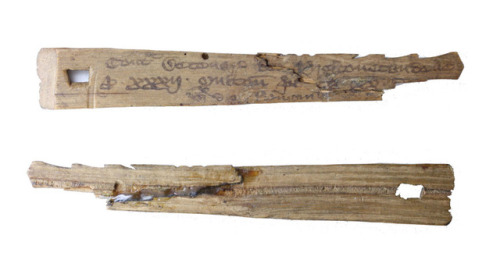peashooter85:Wooden Money in Olde England,The use of tally sticks as an accounting tool goes back to
peashooter85:Wooden Money in Olde England,The use of tally sticks as an accounting tool goes back to ancient antiquity and the dawn of civilization. In an age when the vast majority of people were illiterate, the simplest way represent a certain number of goods was to simply cut markings into a stick, a piece of bamboo, bone, or other similar item. Such systems were common all over the world including Europe, Asia, Africa, and the Pre-Columbian Americas. If you have, say 30 goats, you could go to the market, find an interested buyer, hold up the stick and say, “I have this many goats, want to make a deal?” By the Middle Ages in Europe, Asia, and The Middle East, tally sticks were used as a record of debts, almost like a wooden credit card. An agreement to an IOU was made with the amount notched out on both sides of a stick. The stick was then split in half lengthwise, with one half held by the creditor, and the other half held by the debtor. Believe it or not this system of recording and settling debts continued well into modern times. In 1804 the use of the split tally was acknowledge as legal proof of debt in the Napoleonic Code. The split tally continued in use in Switzerland into the 20th century. When the Bank of England was founded in 1694 as a public corporation, the bank issued tally sticks to it’s investors as proof of their investments. Since the investments were recorded on stocks of wood, they became known as “stocks” and since then the use of the term “stock” for a investment in ownership of a public company has continued to this very day.In 1100 King Henry I of England began issuing tally sticks as a form of money due to a lack of coinage in the kingdom and Europe in genera at the time. The denomination of the stick would be etched onto both sides of the stick. The Dialogue Concerning the Exchequer, written in the 13th century, notes the different denominations as thus,“The manner of cutting is as follows. At the top of the tally a cut is made, the thickness of the palm of the hand, to represent a thousand pounds; then a hundred pounds by a cut the breadth of a thumb; twenty pounds, the breadth of the little finger; a single pound, the width of a swollen barleycorn; a shilling rather narrower; then a penny is marked by a single cut without removing any wood.”Like other split tallies, the stick was split lengthwise, with one half being circulated among the populace as money, and the other half being stored at the local exchequer’s office (treasurer). If one believed they were being cheated with a counterfeit stick, one only had to make a visit to the local exchequer and match his half of the stick with the half held by the treasurer. The use of the split tally for money and the recording of debts ended by act of the British Parliament in 1826. In 1834 Parliament ordered the burning of thousands of ancient tally sticks representing centuries worth of wooden money and debt records to be burning. During their destruction, the chimney of the stove burning the tallies caught fire, resulting in a blaze that destroyed most of the Palace of Westminster. -- source link
Tumblr Blog : peashooter85.tumblr.com


